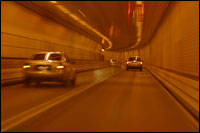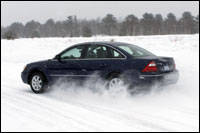| Winter driving (part two) | Dec 28, 2006 |
| Winter driving (part one) | Dec 27, 2006 |
All smooth
In winter driving, all your actions must be done very smoothly. If you abruptly depress the brake pedal or quickly turn the steering wheel, you'll
 |
During a lane change or when driving in a curve, you have to remain as smooth behind the wheel as possible. It's important to anticipate obstacles and road variations in order to prevent sudden reactions. Don't forget to signal your intentions.
Visibility and anticipation
Your ability to see is the key to safe and sound driving. Your vehicle will go where your eyes go. Scan the road and the landscape. Locate the obstacles: ahead, behind and on each side. Always identify an escape exit
 |
In a curve, look ahead to where you want to go. Stop focusing on the nose of your vehicle and look beyond. Go try this on a highway on-ramp and you'll realize that you don't need to make small, non-stop adjustments with the steering wheel. Your hands will remain in the same position almost throughout the entire length of the on-ramp. Consequently, you have better control of your vehicle.
Avoidance
 |
Skidding
Understeer is when the front end of your vehicle starts to skid. If you drive a FWD vehicle, lift your foot from the throttle to allow the front wheels to
 |
| (Photo: Ford) |
Oversteer is when the rear end of your vehicle starts to skid. Again, lift your foot from the throttle and steer the wheel in the opposite direction of the skidding to bring the vehicle back in a straight line. If you act abruptly during these maneuvers, you'll increase the initial skidding and have harder time getting out of trouble.


